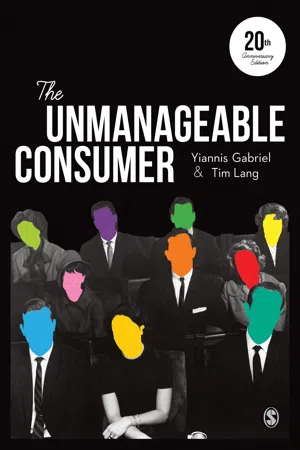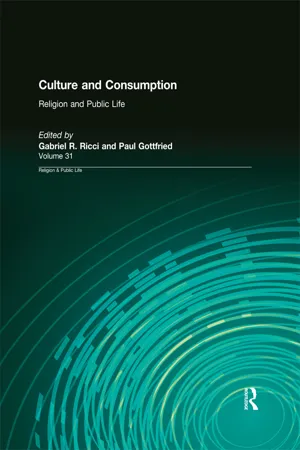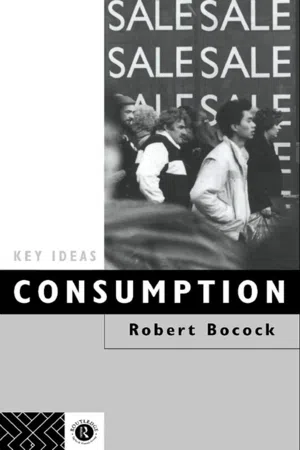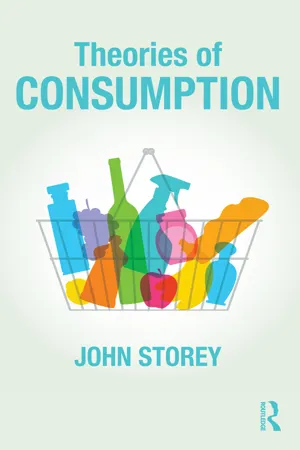American Consumerism
American consumerism refers to the culture of excessive purchasing and consumption that emerged in the United States, particularly after World War II. It is characterized by a focus on material possessions, mass production, and advertising. American consumerism has had a significant impact on the economy, society, and environment, shaping the way people live and interact with products and services.
6 Key excerpts on "American Consumerism"
- Jerald Podair, Darren Dochuk, Jerald Podair, Darren Dochuk(Authors)
- 2018(Publication Date)
- Routledge(Publisher)
...29 Consumerism and Popular Culture—A Historiographical Survey Emily A. Remus On the threshold of the twentieth century, economist Simon Patten theorized that the United States was evolving from a “pain economy” rooted in scarcity to a “pleasure economy” based on abundance. The transition had been sparked by new manufacturing and distribution methods that granted consumers access to an ever-increasing array of goods—from ready-to-wear clothing to convenience foods to home appliances. As Americans came to rely on getting and spending to fulfill more of their everyday wants and needs, consumption levels soared to unprecedented heights. Yet sustaining these conditions, Patten predicted, would require a break with the past, a remaking of old “ideals, impulses, and institutions.” The effects of the break would be far-reaching. Indeed, in Patten’s view, the growth of the consumer economy was destined to transform everything from morals and customs to civic standards, social relationships and the built environment. In short, the ascent of consumer capitalism would create American culture anew. 1 For nearly a century after Patten marked the leap from scarcity to abundance, the study of consumer culture remained mainly the province of economists, political theorists and cultural critics. Only in the 1970s, amid the “cultural turn,” did historians begin to devote sustained attention to consumption. That initial research focused on advertising, commercial amusement and the development of a mass market. 2 But in the decades that followed, interest in consumer culture penetrated new subfields and areas of inquiry, moving from intellectual and cultural history to intersect with urban history, women’s and gender history, business history, political history and the histories of race, civil rights, sexuality and the United States in the world...
- eBook - ePub
- D.G. Brian Jones, Mark Tadajewski, D.G. Brian Jones, Mark Tadajewski(Authors)
- 2016(Publication Date)
- Routledge(Publisher)
...consumer individualism) and lack of collective action to reform larger political processes (Maniates, 2002). Conclusion This chapter has provided a mere thumbnail sketch of the history of consumption in the United States. It does not do justice to the potential richness of the topic, but does offer a theoretically informed introduction. The narrative has followed three phenomena studied in the field of consumer culture theory – the meaning of possessions, the gender of consumption and opposition to consumption – through different time periods and has showed examples of continuity, and instances of change. The meanings of possessions have been constantly in flux over time, while the history of the gender of consumption appears more purposeful: largely male in the colonial era, it became increasingly feminized in the second half of the nineteenth century through the early twentieth centuries. Although some of the specifics have changed, anti-consumption thought has shown broad continuities in motives (religious, philosophical, political) and in its behavioural expressions (boycotts, voluntary simplicity). These threads are important, but constitute just a small part of a larger fabric of American consumption history. Since the seventeenth century, Americans have made repeated efforts to ‘protect’ consumers from themselves by regulating alcohol, drugs, gambling, prostitution and other perceived vices (Hollander, 1984). In the twentieth century, the consumer movement has protected, through education, litigation and regulation, the rights of buyers from infringements by companies and governments (Herrmann and Mayer, 1997). Critiques of advertising, branding and other so-called evils perpetrated on American buyers by the marketing mixes of corporations have been a cottage industry for quite some time (see e.g. Klein, 1999 ; Packard, 1957)...
- eBook - ePub
- Yiannis Gabriel, Tim Lang(Authors)
- 2015(Publication Date)
- SAGE Publications Ltd(Publisher)
...To be sure, a central feature of consumerism is the separation of the at times squalid circumstances of the production of commodities from their glamorized circulation and sale (Frenkel et al., 1999; Klein, 2000; Korczynski, 2001a; Korczynski, 2001b). Yet, patterns of consumption are crucially linked with developments in the nature of production. The consumer is ultimately the same person as the worker or manager now threatened by continuous mechanization of production and distribution or by the flight of capital to lower wage economies. Equally, international capital has a lot at stake in seducing the displaced peasant and exploited workers of low income countries and converting them into consumers aspiring after Western standards (e.g. Sklair, 1995; Prahalad, 2004; Seabrook, 2004). The emergence of contemporary consumerism As a mass phenomenon, consumerism may be a distinctly 20th century one, but particular patterns of consumption have held important social meanings throughout history, something explored by a number of scholars. In a pioneering study, McKendrick explored the consumption of the affluent in the early part of the industrial revolution, when the commercialization of fashion turned the British middle class into avid spenders (McKendrick et al., 1982). Rosalind Williams looked at the rampant consumerism of the Parisian bourgeoisie and the arrival of mass consumption through the institution of department stores in the late 19th century (Williams, 1982). Mukerji went further back and examined conspicuous consumption among Elizabethan nobility, fuelled by the discovery of ‘fashion’ and the arrival of nouveaux riches (Mukerji, 1983). What sets modern consumption apart from earlier patterns is not merely the growth of spending power across social classes and strata, but, more importantly, the experience of choice as a generalized social phenomenon...
- eBook - ePub
- Gabriel R. Ricci, Gabriel R. Ricci(Authors)
- 2017(Publication Date)
- Routledge(Publisher)
...The Dialectic of Consumption: Materialism and Social Control in American History David Brown Throughout American history a pattern of escalating consumer demand has served as a basis for social control. A consumption culture, predicated upon the belief in ever-rising living standards, efficiency in production, and the intrinsic value of a commodity-oriented lifestyle has undermined personal autonomy. Where the ethic of accumulation has won out, patterns of local control, traditional value systems, spiritual life, and other forms of cultural expression have been gutted. The relationship between consumption and centralized control in our nation’s past demonstrates that a design of behavioral regulation was behind the destruction of Native American autonomy in the Colonial period; the creation of a bourgeois/middle-class consciousness in the early nineteenth century; the reduction of the power of organized labor in the post-Second World War broker-state; and in the attempt by Wilsonian internationalists and their heirs to temper a chaotic global community through the spread of a uniquely American form of democratic consumer capitalism. At first glance these episodes may seem disparate and disconnected from one another. Yet in each of these cases the state had a direct interest in undermining autonomous or semi-autonomous populations in order to create community standards that would be aligned with market sensibilities. Organized labor’s role as an advocate for social justice, for example, was deemed useful in the Depression era, but fit awkwardly into the bipartisan Cold War culture of the 1940s and 1950s. The elevation of the “laborer” to the status of “consumer” diminished the role of unions in economic life by inducing workers to accept membership in a mass consumer society. Indeed, the laborer joined a burgeoning group of Americans who were increasingly intent on self-identification through material items rather than work skills or artisan affiliation...
- eBook - ePub
- Dr Robert Bocock, Robert Bocock(Authors)
- 2008(Publication Date)
- Routledge(Publisher)
...1 The emergence of modern consumerism The social and cultural processes surrounding consumption in western capitalism during the twentieth century have been influ-enced by earlier cultural values, carried by various social status groups into the modern capitalist period. Among these carriers of cultural values, the early rational, peaceable, bourgeois capitalists of Britain and Holland, whose world-view was analysed by the German sociologist Max Weber (1864–1920) in The Protestant Ethic and the Spirit of Capitalism, have played a crucial role of world historical significance. Their migration, sometimes forced upon them, across the Atlantic, laid the basis of the modern United States of America—the social formation which has come to epitomise the modern consumer’s dreamland, or heaven on earth. The analysis Weber provided of this group, the early rational, Calvinist capitalists of the seventeenth century, will be discussed briefly here, before looking at later changes to this cultural patterning underpinning rational capitalism in the eighteenth century. The changes in patterns of consumption during late nineteenthand early twentiethcentury capitalism, up to the outbreak of the First World War in 1914, will be discussed in the light of the sociology of consumption from Veblen and of the newly emerging metropolitan life-style analysed by Simmel. The period of the two world wars, and the intervening economic recession and depression of the 1920s and 1930s, was one in which capitalism failed to deliver consumer goods to the working classes. Reflecting this bleak and violent economic and political period, sociologists concentrated on other issues, such as the appeal of fascism, rather than upon consumption. The story of the social and cultural role of consumption in modern, western capitalism continued with the growth of what was often called at the time, that is in the 1950s and 1960s, ‘the growth of mass consumption’...
- eBook - ePub
- John Storey(Author)
- 2017(Publication Date)
- Routledge(Publisher)
...8 Consumerism and Consumer Society All the previous chapters have focused on different ways to think about consumption. In this chapter we will explore debates around consumerism and consumer society. I will begin with a brief discussion of the difference between consumption and consumerism, as too often the terms are mistakenly used interchangeably. This will be followed by a critical engagement with the birth of consumer society, anti-consumerism, advertising and commodity activism. Consumption and consumerism Karl Marx distinguishes between ‘production in general’ and specific historical modes of production. As he explains it, production in general ‘is common to all social conditions, that is without historic character, human ’ (1973: 320). But the human need to produce is always located historically in a particular mode of production: i.e. humans have always produced but how they produce is always historically situated. In other words, there is a difference between a slave mode of production and a capitalist mode of production. If we think of this in terms of consumption, we arrive at similar conclusions: there is ‘consumption in general’ and there are specific modes of consumption. Humans have always consumed, but in different historical periods we have consumed differently. As Marx points out, Hunger is hunger, but the hunger gratified by cooked meat eaten with a knife and fork is a different hunger from that which bolts down raw meat with the aid of hand, nail and tooth. Production thus produces not only the object but also the manner of consumption, not only objectively but also subjectively. Production thus creates the consumer (1973: 92). Our contemporary attitudes to consumption, our consumption practices and our consumption desires, have developed alongside the historical development of capitalism as a mode of production...





